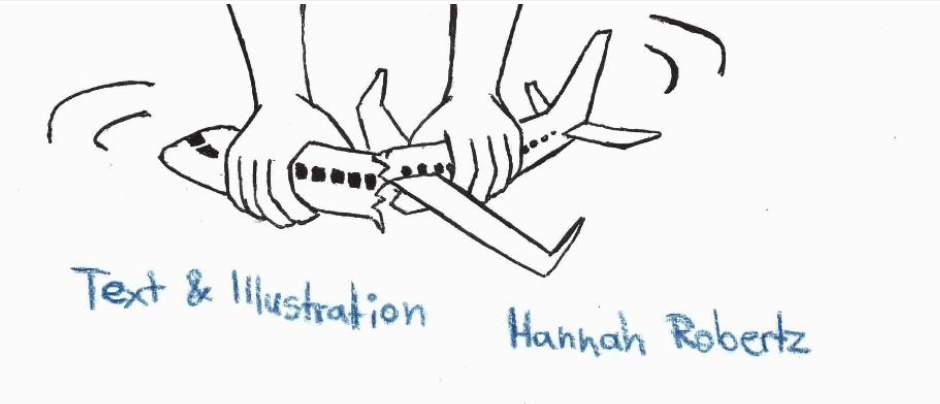
.
.
.
.
.
.
.
.
.
.
.

.
.
.
.
.
.
.
.
.
.
.
.
.
.
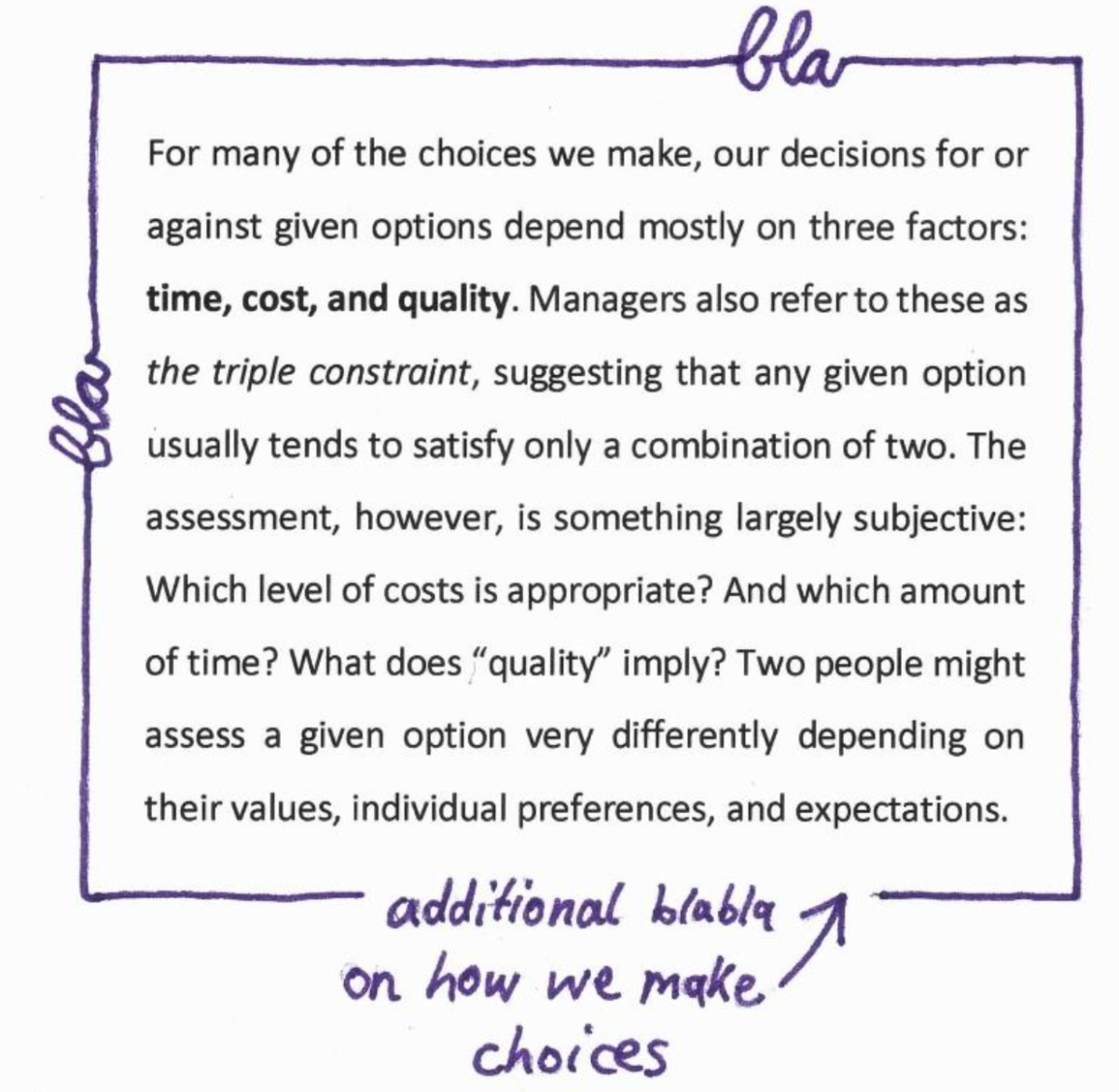
I recently came across an article from 2014 titled “10 Reasons Why Flying is Still the Best Way to Travel“1. The author legitimately points out that some places simply cannot be reached in another way, and that flying is fast as well as “surprisingly affordable”. The “still” in the article’s title got me waiting to hear about some disadvantages of flying too, but any such comment, e.g. on the climate footprint of aviation, was searched for in vain. Indeed, I found it rather cynical that the website, fIightnetwork.com, next suggested reading “4 Reasons to Visit the Canadian Arctic This Summer”2
That taking an airplane has a relatively large negative impact on our planets climate, is no secret, it’s an uncomfortable fact.
It is also a matter a fact that, in our globalised world, airplanes have become an increasingly important means of passenger transportation. In the cases of business travel or international friends – and family visits one might even say – a necessity.
But as our present and future are and will be characterised by both, globalization and the imminent climate crisis, the search for more climate-friendly alternatives to flying the way we do today is becoming a burning issue.
Speaking of potential alternatives to flying one can generally distinguish three options: Either, one manages to improve the climate footprint of aviation, changes the means of transport, or the general travel plan.
Changing plans could mean spending holidays in more closely located destinations and/ or, as National Geographic3 suggests, traveling to fewer places, spending more time on each.

In how far people will be willing to change their general travel behaviour in the future also depends on the future success of the sustainability- movement that has gained momentum with the huge demonstrations organised by Fridays for Future Future in 2019. As regards the reduction of aviation’s climate footprint, much depends on future technological developments.
All these things are still up in the air, and therefore rather difficult to predict. That’s why my research for the study-project this article is based on focused on the alternative-means-of-transport-option. *
Changing the Means of Transport.
As I already mentioned, Becker1 is probably right when he claims that “The days of taking a slow boat to Europe – or anywhere else in the world for that matter – are long gone.”
Yet, the following graph4 shows that, compared to flights within Europe and domestic flights, intercontinental flights historically account for the smallest part of departures from German airports. This suggests that alternative means of transport might in fact be conceivable for the largest share of Germans’ journeys.
.
.
.
.
.
.
.
.
.
.
.
.
.
.
.

.
.
.
.
.
.
.
.
.
.
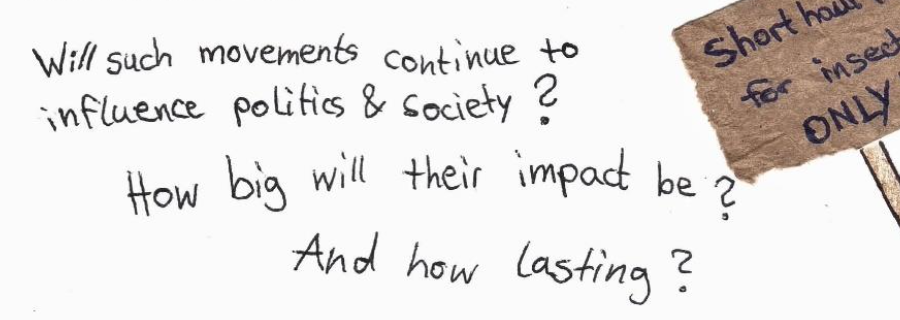
.
.
.
.

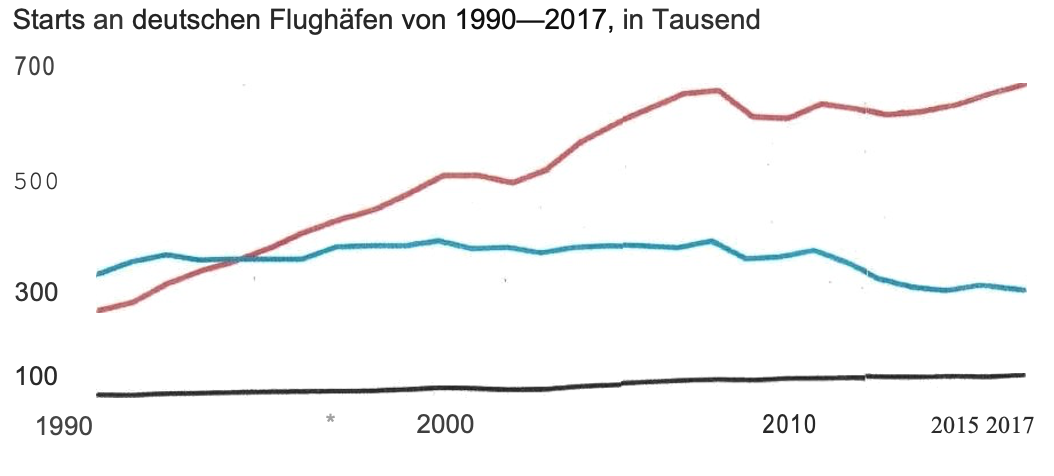
.
.
.
.
.
.
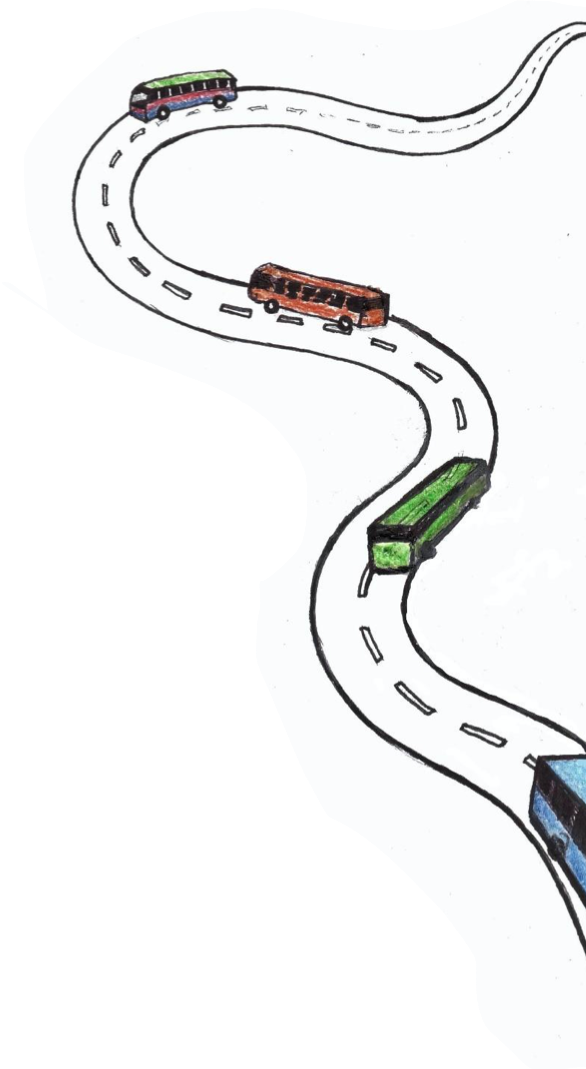
Cars. In a guideline for business travel5, which the VerkehrsclubDeutschlandpublished in 2008, it was suggested to use cars, busses, or trains for distances up to 50 km, and trains for distances up to 500 km. Are cars and busses thus already ruled out as potential alternatives to flying?
Well, Germany’s shortest domestic flight currently covers only 150 km, taking 23 min to transport passengers from Nuremberg to Munich and vice versa 6.
If one would bicycle all the way, one could probably do so within two days.
So, it seems that cars actually do provide a realistic alternative to some domestic flights.
The disadvantages: Driver’s license and access to a car are needed. Driving requires a lot of concentration. Unless there are multiple drivers that can alternate, one can only cover rather limited distances, and cannot be productive during travel.
Productivity, however, is a factor most companies consider: In a 2019-survey7, 79 % of the interviewed companies stated they would pay some or even very close attention to their employees’ productivity during travel.
While autonomous driving and electric drive might allow the car of the future to overrun some of its current issues, the widespread implementation of these technologies is still dreams of the future for now: The Prognos-Research Centre’ estimates that autonomous driving will become the rule earliest by 2040.
Busses.Since the German government allowed for more competition in long-distance bus line transport in 2013 the network has grown considerably 9. Flixbus,ICbus,blablabus,& Co are now offering affordable environmentally friendly alternatives for city-to-city-travel. As the following graph 10 shows, long-distance busses perform best in terms of emission per person and kilometer compared to planes, trains, and cars:
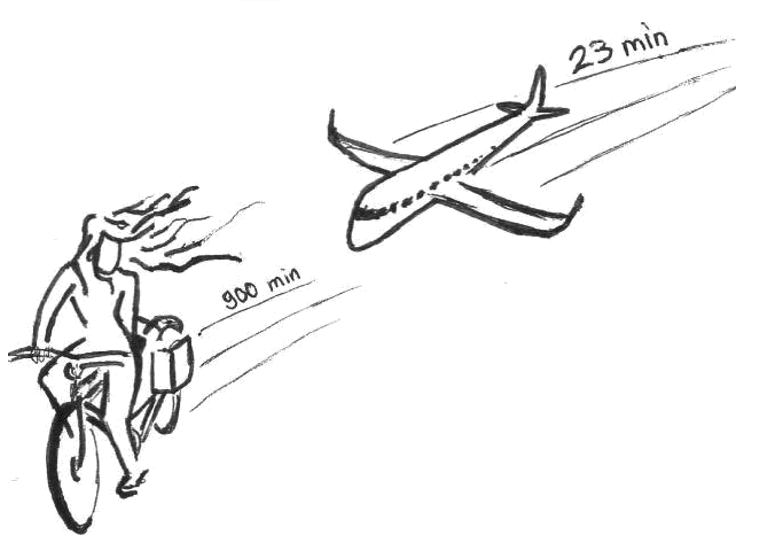
.
.
.
.
.
.
.
.
.
.
.
.
.
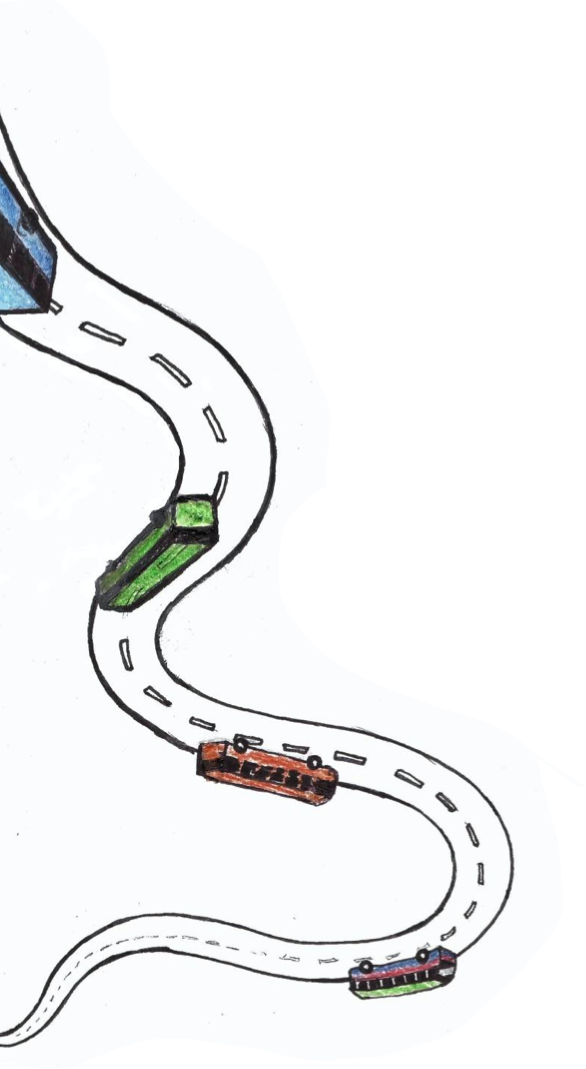
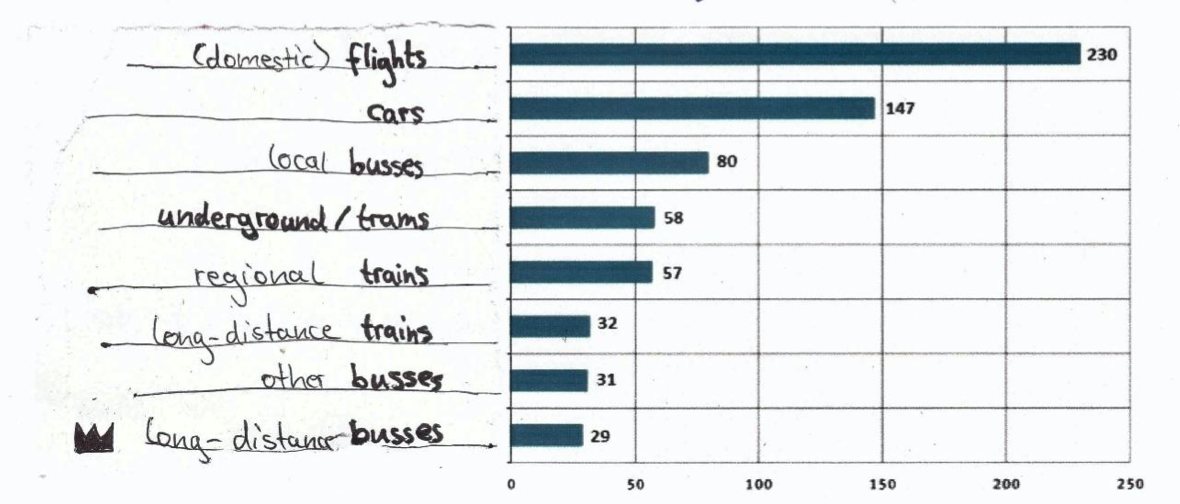
The disadvantages: Busses perform worse in terms of time and don“t provide a lot of comfort. Personal space is very limited, and the ride can be rather unsteady at times.
Maybe these aspects also help explain why a 2017- survey11 found that only few passengers take a Flixbus for business purposes whereas the majority is using them to go on holidays or visits.

.
According to a 2017- study12 by the Wuppertal Institute, potentially, trains could completely replace domestic flights by 2035.
lndeed, new high-speed rail connections have already substituted previously popular domestic flight routes, such as Hamburg-Berlin, Nuremberg- Berlin, and Cologne-Frankfurt13.
The following graph14 further supports this observation, showing how aviation passenger kilometres declined once a high-speed rail line has been implemented for different connections within Europe and China:
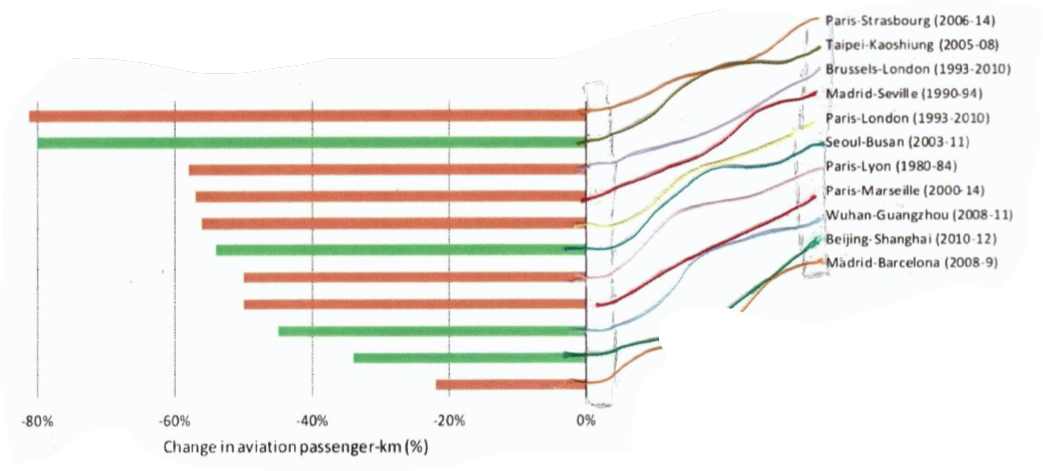
.
.
.
.
.
.
.
.
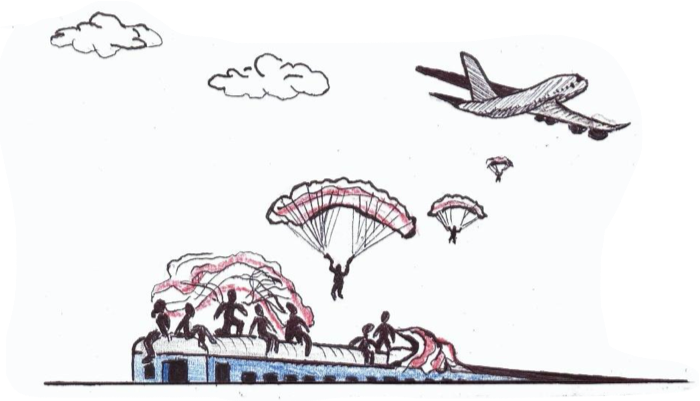
.
.
.
.
.

.
Throughout the last two decades, the European high-speed rail network has grown considerably: Supported by 23.7 Mio € from the EU‘s Trans European Network Programme, 10. 000 km high speed rail lines have been created. The plan is to further extend the network, reaching 30.000 km by 2030. In addition to highspeed trains, night trains could be key to reduce and eventually replace flights within Europe. On high speed tracks, they can cover up to 1.500 km per night 15.
While the DeutscheBahnsold its last sleeper cars to the Austrian ABB in 2016, European night trains have recently experienced a comeback: Responding to increasing demands, several countries declared to modernize lines and open up new ones, or have already started to do so16. Tickl2ts for night trains are usually still higher than for flights, but, for 2019, atravel agent in Freiburg observed that the number of people choosing night trains over low cost carriers despite the prize difference has increased. The OBB pointed to a Greta-Effect 17.
Night trains recent success can only be explained+ with regards to some of their crucial advantages: Traveling by night saves accommodation costs, passengers are less exhausted, and have more time to be productive. This makes night trains very attractive, also for business travel.
Christian Schwägerl from the FAZ 17 sees great future profiling potentials: A whole new way of travel would be conceivable: Future night trains might offer extras reaching from co-working-spaces over fitness-centres and bars to glass-roofed wagons for star gazing.
Whereas the prementioned visions may sound rather fantastic, the OBB is already putting increased emphasis on comfort and has ordered 13 new night jet trains of highly modern design. Meanwhile, the DB offers night connections in normal trains for cheap prizes, attending to the same target group that commonly uses the cheap long-distance busses. It is said to be unlikely that they will re-enter into night train business buying new sleeper cars any time soon, but the DB aims to cooperate with other providers more closely18.
.


.
.
.


.
.
.
.
.
.
.
.
.
.
–
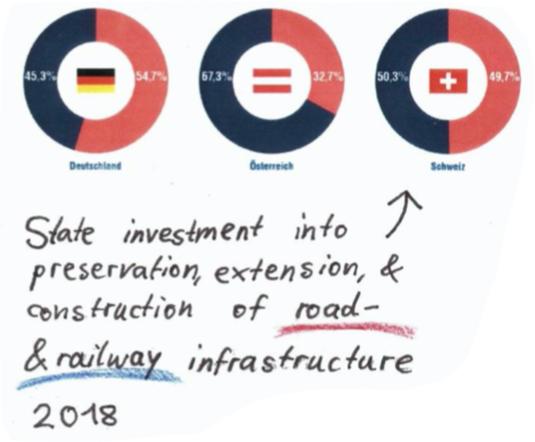
Conclusion.After all, it seems to be only a matter of time before long distance busses and trains will gradually replace domestic flights as well as greater shares of the flights within Europe.
How fast this is going to happen not least depends on political will: Anna Deparnay-Grunenberg15 and Michael Cramer19, both members of Germany’s Green party, point out that investments and the implementation of alternative-friendly policies are necessary to make the change happen.
It appears that Germany still has a lot to catch up in this regard: Status of 2017, only 5% of DB’s passengers were traveling on high speed trains and 40% of German train tracks were not even electrified ye19. Many countries are long ahead of Germany when it comes to investing into the railway, as the following diagrams20 show.
Now that I have written so much about transport alternatives, I want to at least mention another alternative to flying many of us have recently become more familiar with: Virtual meetings.
According to the 2019-survey Chefsache Business Travel7, 1 out of 4 business trips has already been replaced by virtual meetings in 2018.
One can find it surprising that turning to this alternative took us so long, considering that the VCD already suggested to replace business trips with virtual meetings in its 2008-guideline5.
In context of the COVID-19 restrictions, meetings have finally received a strong forward push, and as they save time and costs as well as emissions it is to be expected that they will play an important role in replacing considerable parts of business travel in the future.
Yet, this is not the only chance the Corona Crisis provides us:
The current pandemic is a chance to realize that certain things are more important than continuing business as usual, that there are issues which require us to change our habits, because they cannot be tackled unless we do, and this may imply resisting from doing some things we previously enjoyed.
What might be even more important:
We got to see that all this is in fact possible, and we experienced that, in the midst of crisis, we can become creative and bring about positive change. Many of us are wondering how the world is going to look like after Corona. I‘d say, let‘s see the chances that hide within the crisis, a chance to start breaking with some bad habits for example.
And after Corona?
I’d say, let s keep it up & stay on the ground more often.
Convincing alternatives are not always available, but in most of the cases, we do have a choice.
.
.
.
.
.
.
.
.
.
.
.
.
.
.
.
.
.
.
.
.
.
.
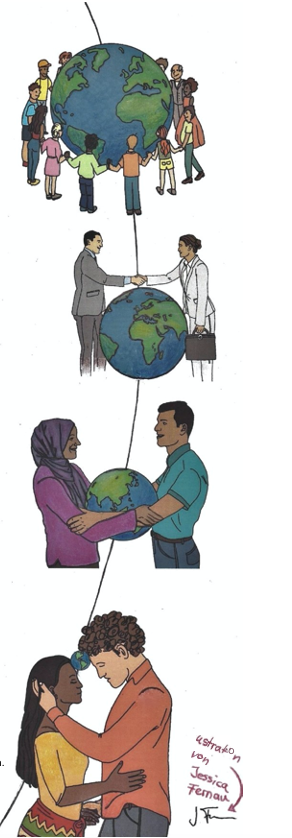

References
1 Becker (2014). TO Reasons Why Flying is Still the 6esf Way to Travel. Flightnetwork.com. Retrieved on May 29a 2020 from https://www.flightnetwork.com/blog/10-reasons-why-flying-is-still-the- best-way-to-travel/
2 McCaffrey (2017). 4 reasons to Visit the Canadian Arctic This Summer.
Flightnetwork.com. Retrieved on May 29a 2020 fromhttps://www.flightnetwork.com/blog4-reason-to-visit-the-canadian-arctic-this-summer/
3 Chrin, C. (2017, July 11). 6 ’days to Be a More Sustainable Traveler. National Geographic. https://www.nationalgeographic.com/travel/lists/sustainable-travel- tips/
4 Ahr, N., Asendorpf, d., & Pinzler, P. (2018, August g›. die Ho/ie am Himmel. Die Zeit. https://www.zeit.de/2018/33/flugverkehr-fliegen- flughafen-chaos-billi@ieger-vielflieger/komplettansicht
5 Hanel, A., Spottka, F., Kaminski, B., Lange, & K., Berkner, C. (2008). VCD Leitfaden Geschäftsreisen – erfolgreich, effizient, umweltverträglich. Verkehrsclub Deutschland. Page 28. https://www.vcd.org/fileadmin/user_upload/Redaktion/Publikationsdat enbank/Tourismus/VCD_Leitfaden_Geschaeftsreisen_2008.pdf
6 Mitteldeutscher Rundfunk. (2020, January). Der kürzeste Flug dauert nur 23 Minuten. https://www.mdr.de/wissen/faszination- technik/inlandsfIuege-in-deutschland-100.html
7 Deutscher Reiseverband. (2019). Chefsache Business Travel- Studie 2019. https://www.chefsache-businesstravel.de/wp-content/uploads/2019/12/DRV-Berichtsband-Business-Travel-2019.pdf
8 Altenburg, S., Kienzler, H., & Auf der Maur, A. (2018). Einführung von Automatisierungsfunktionen in der Pkw-FIotte-Auswirkungen auf Bestand und Sicherheit. Prognos.https://www.adac.de/-/media/pdf/motorweIt/prognos_automatisierungsfunktionen.pdf?la=de-de&hash=4FE03D2842A22A8F900AE176AFCA6887
9 Winterer, C. (2020, January 16). Fernbus: Wie “dko ist er inn Vergleich zu Bahn, Auto, Flugzeug? Utopia. https://utopia.de/ratgeber/fernbus- vergleich-bahn-auto-flugzeug/
10 Umweltbundesamt. (2020, March 11). Emissionsdaten. https://www.umweltbundesamt.de/themen/verkehr- Iaerm/emissionsdaten#handbuch-fur-emissionsfaktoren-hbefa
11 Omnibus News. (2017, October 4). Wer fährt Fernbus? https://omnibus.news/wer-faerhrt-fernbus
12 Rudolph, F., Koska, T., & Schneider, C. (2017). Verkehrswende für Deutschland – Der Weg zu CO2-freier Mobilität bis 2035. Wuppertal Institut. https://www.greenpeace.de/sites/www.greenpeace. de/files/20170830- greenpeace-kursbuch-mobiIitaet-langfassung.pdf.pdf
13 Le Blond, J. (2020, January 29). Why Germans are flying less. BBC. https://www.bbc.com/worklife/article/20200128-why-germans-are- flying-less
14 Timperley, J. (2019, January 30). Eight charts show how ’aggressive’ railway expansion could cut emissions. Carbon Brief. https://www.carbonbrief.org/eight-charts-show-how-aggressive-railway- expansion-could-cut-emissions
15 Schwietering, c. (2020, January 14). Inn ICE von Frankfurt nach Barcelono. Zeit Online. https://www.zeit.de/mobilitaet/2020- 01/zugverkehr-christian-Iindner-hochgeschwindigkeitsstrecke-eu- kommission/komplettansicht
16 Rail, E. (2019, June 11). Once Threatened, Europe’s Night Trains Rebound. The New York Times. https://www.nytimes.com/2019/06/11/travel/europe-overnight- trains.html
17 Schwagerl, C. (2019, October 21). Renaissance der Nachtz’ñge-Wer wird denn gleich jn die Luft gehen. Frankfurter Allgemeine Zeitung.https://www.faz.net/aktuell/reise/renaissance-der-nachtzuege-die- alternative-zum-fliegen-16430220.htmI7printPagedArticIe=true@ageIndex_4
18 Krummheuer, E. (2020, January 20). Wo Schnell- Und Nachtzug eine gute Alternative zum Flug sind. Welt.https://www.welt.de/reise/nah/articIe205085354/Bahnfahrt-Wo-Zuege- eine-gute-Alternative-zum-FIug-sind.html
19 Niranjan, A. (2017, December 8). Unfair competition: The battle between high-speed rail and law-cost airlines. Deutsche Welle. https://www.dw.com/en/unfair-competition-the-battle-between-high- speed-rail-and-low-cost-airlines/a-41716660
20 Allianz pro Schiene. (2019, June). Deutschland investiert zu wenig in die Schieneninfrastruktur. https://www.allianz-pro-schiene.de/themen/infrastruktur/investitionen/